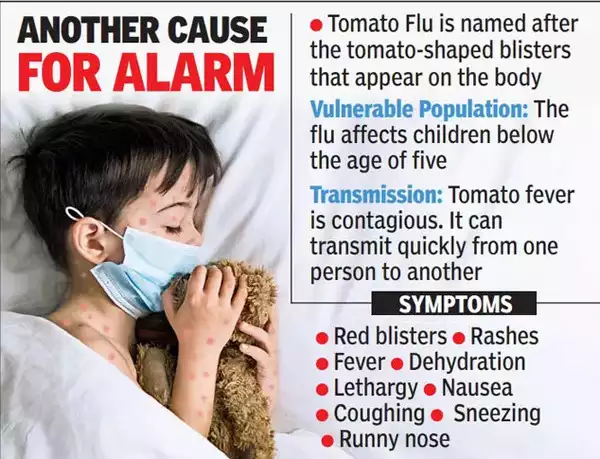Tomato Flu or Tomato Fever

On May 6, 2022, the Kollam district of Kerala reported its initial case of tomato flu. According to findings published in The Lancet, despite displaying symptoms akin to Covid-19, the tomato flu virus is distinct from SARS-CoV-2. It is believed that the causative agent for tomato flu might be a variant of the virus responsible for Hand, Foot, and Mouth disease, typically affecting children below the age of 5 and individuals with compromised immune systems.
The illness was given its name due to the widespread appearance of painful, red blisters all over the body that eventually resembled tomatoes in shape. According to reports, infectious disease is uncommon and self-limiting. Although it does not now threaten human life, careful management is necessary to prevent it from spreading.
Concerns arose in the district as approximately 80 children were affected by the flu. The cases, exhibiting similar symptoms, were identified in Anchal, Aryankavu, and Neduvathur, primarily among children aged five and below. If you notice any of these symptoms in your child, it is advisable to promptly seek medical attention at the nearest hospital for immediate diagnosis and treatment.
The Health Department is closely monitoring the uptick in flu cases, particularly among children under the age of five. The situation is worrisome as all confirmed cases have been recorded in local government hospitals and exclusively involve children. Notably, there were 172 reported cases of Tomato Fever in Kollam alone.
Whom does Tomato Flu Most Affect?
With reports indicating well over 80 detected cases nationwide, the tomato flu has primarily impacted children between the ages of 1 and 9, raising concerns among authorities. Children in this age group are not only the most susceptible to the disease but also act as the primary carriers, contributing to its spread. Given the commonality of viral infections in young children and the likelihood of transmission through close contact, they are more prone to exposure to the tomato flu.

Young children can contract the virus by touching contaminated surfaces, using diapers, and putting objects directly into their mouths.
Due to its similarities to hand, foot, and mouth disease, there is a significant risk of tomato flu spreading to adults if the outbreak in children is not contained and halted.
Symptoms of Tomato Virus:
Symptoms associated with the Tomato virus closely resemble those of Chikungunya, featuring high fever, body aches, joint swelling, and fatigue. Additionally, several other symptoms warrant attention.

Primary Tomato Virus Symptoms:
- Tomato-like red blisters
- High fever
- Dehydration
- Swelling in the joints
- Body ache
- Rashes
- Lethargy
Other Symptoms Include:
- Discoloration of hands, knees, and buttocks
- Nausea
- Sneezing
- Runny nose
- Vomiting
- Abdominal cramps
- Fatigue
- Coughing
Tomato Flu Causes:
The exact reasons for the Tomato virus are yet unknown, and health officials are actively investigating the origins of Tomato fever. Reports indicate that the virus has affected parts of Kollam in India, prompting health authorities to take preventive measures to curb its spread.
Influenza Transmission:
Similar to other types of flu, Tomato fever is highly contagious. Individuals diagnosed with the flu should practice isolation to prevent rapid transmission.
Tomato Flu Precautions for Prevention:
Tomato flu, like other influenza strains, is highly contagious. It is crucial to isolate suspected or confirmed cases and implement additional preventive measures to curb the infection’s spread. Isolation should be practiced for 5-7 days after the onset of symptoms to prevent the virus from spreading to other children or adults.
The most effective prevention method involves maintaining good hygiene practices, regular sanitization of the immediate environment, and ensuring that the infected child refrains from sharing items such as toys, clothes, food, or other objects with healthy children.
Tomato Flu Treatment and Preventive Measures:
The most effective means of avoiding the flu is to maintain good hygiene practices. Regular sanitation of the environment is crucial. While all symptoms can be treated conventionally, it is essential to refrain from scratching or rupturing the blisters to prevent exacerbation.
In the case of children exhibiting Tomato virus symptoms, parents should seek emergency medical attention. Patients are advised to get ample rest to mitigate potential long-term effects of the fever.
It is crucial for children affected by the Tomato flu to consume filtered water for hydration. Avoiding scratching or rupturing blisters and rashes is essential. Maintaining proper hygiene and cleanliness is paramount.
Family and friends should refrain from close contact with the affected person, as Tomato fever may have life-threatening effects.